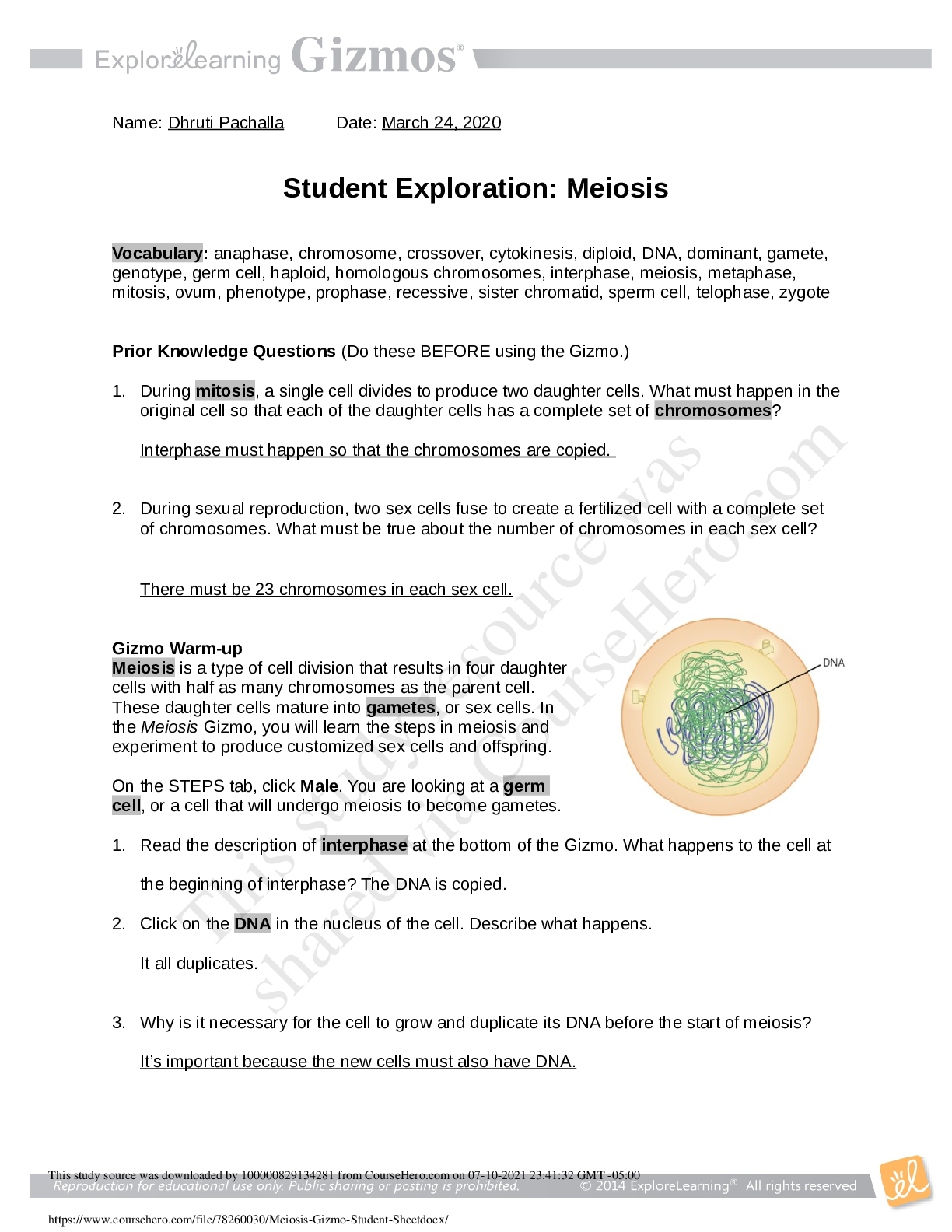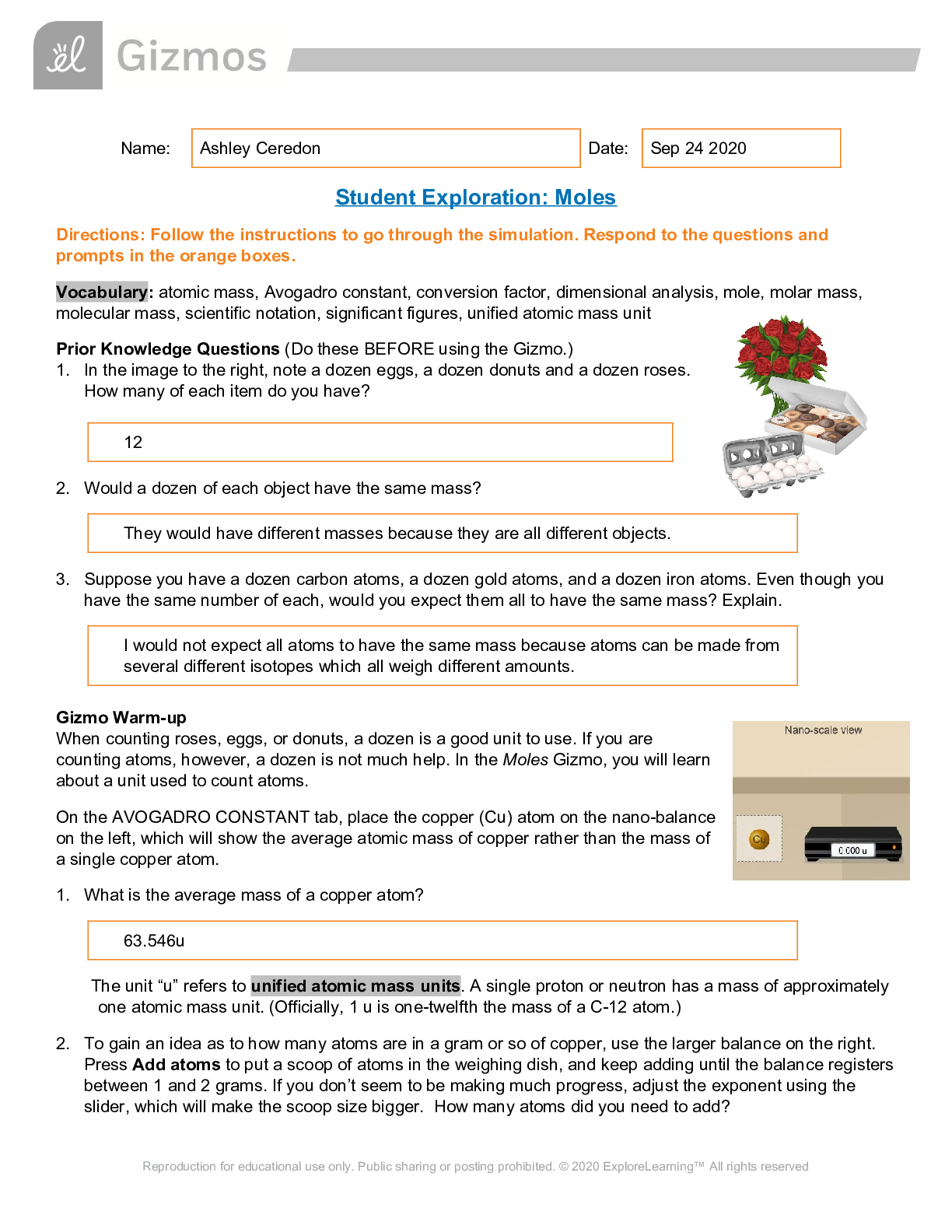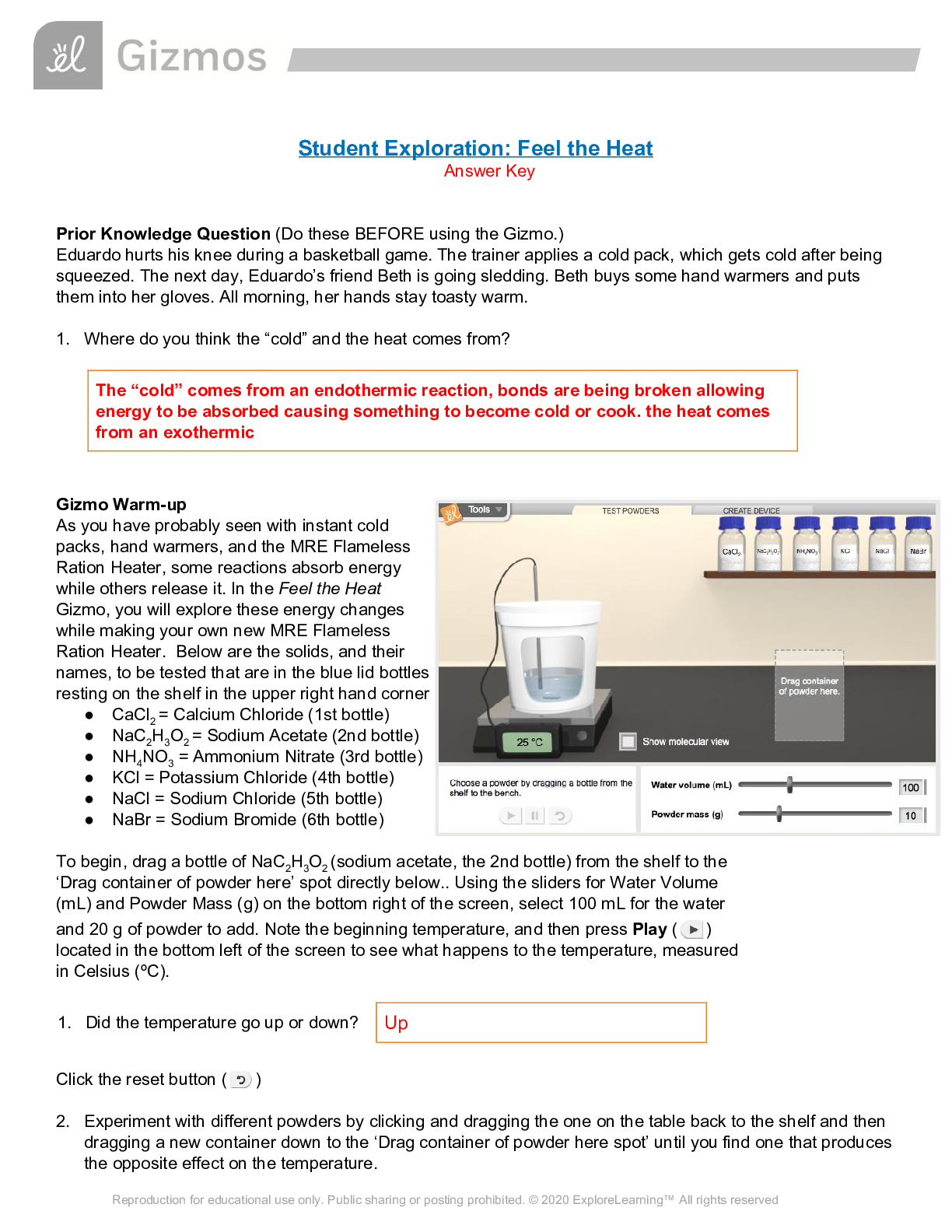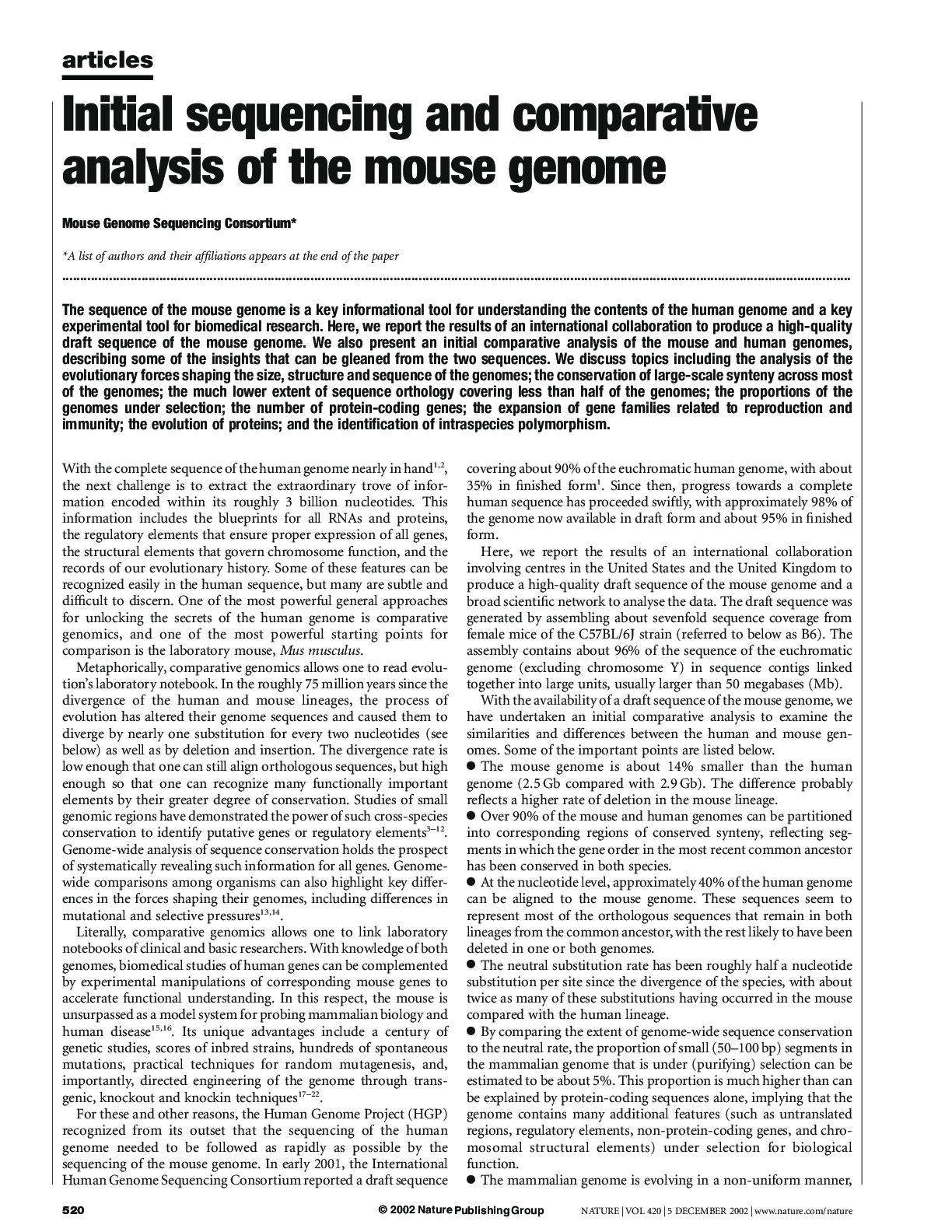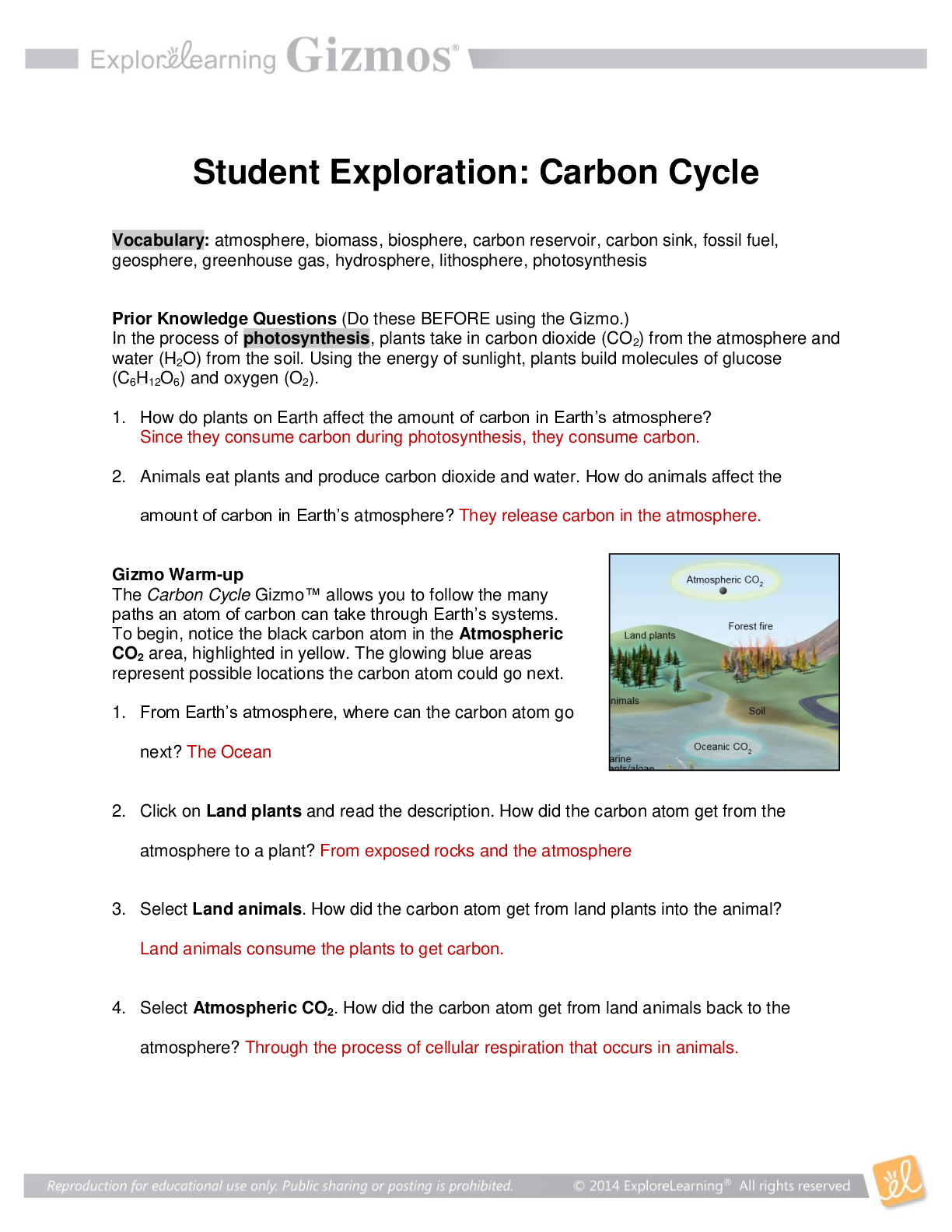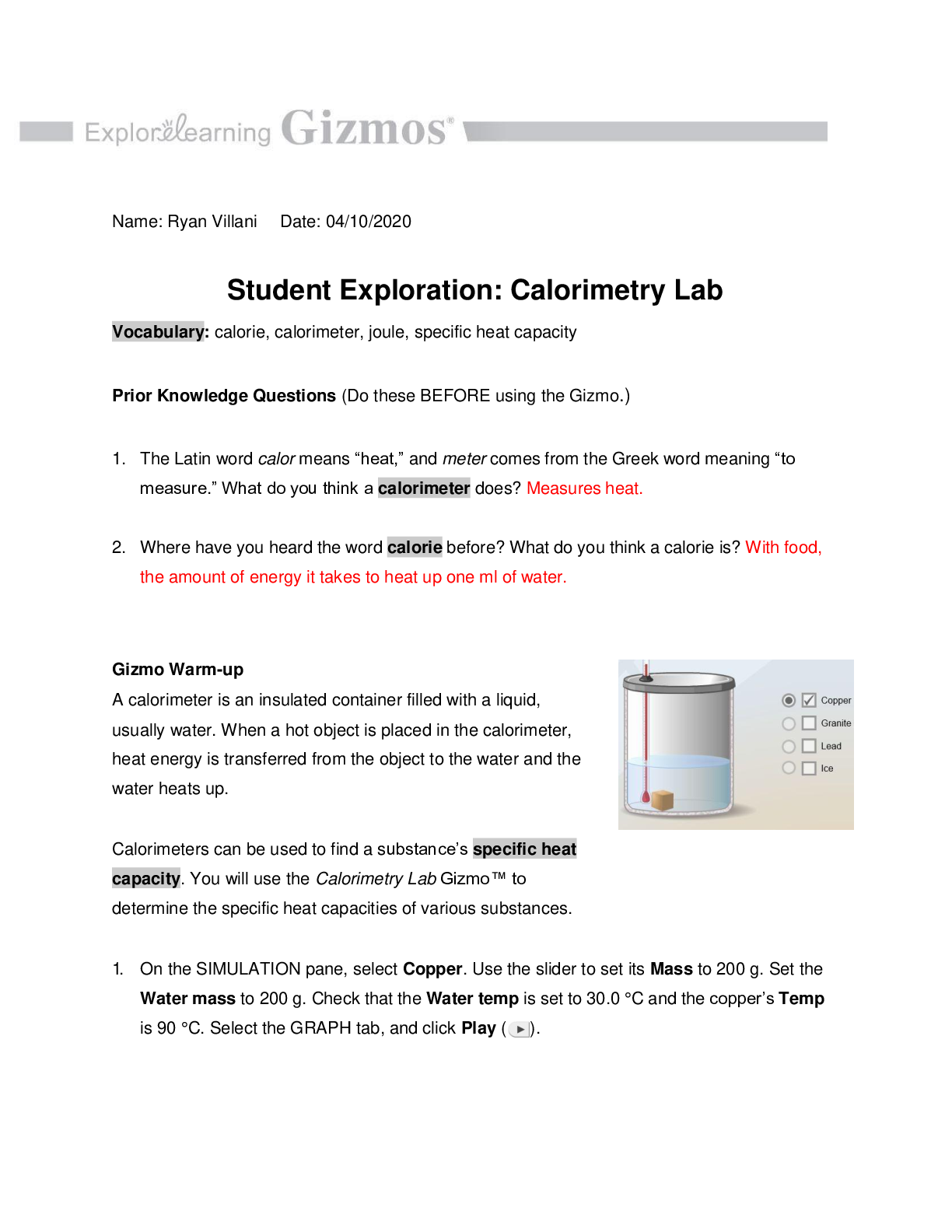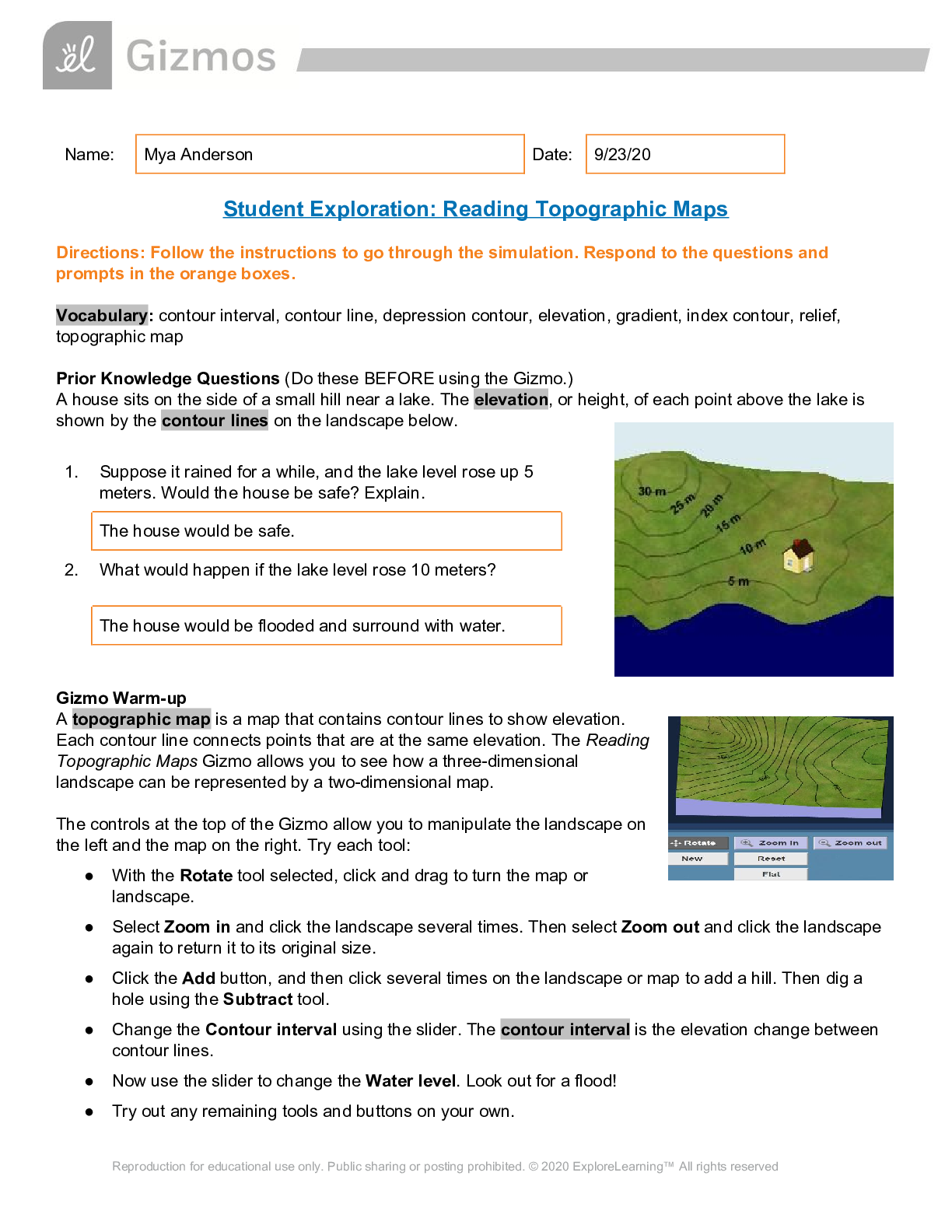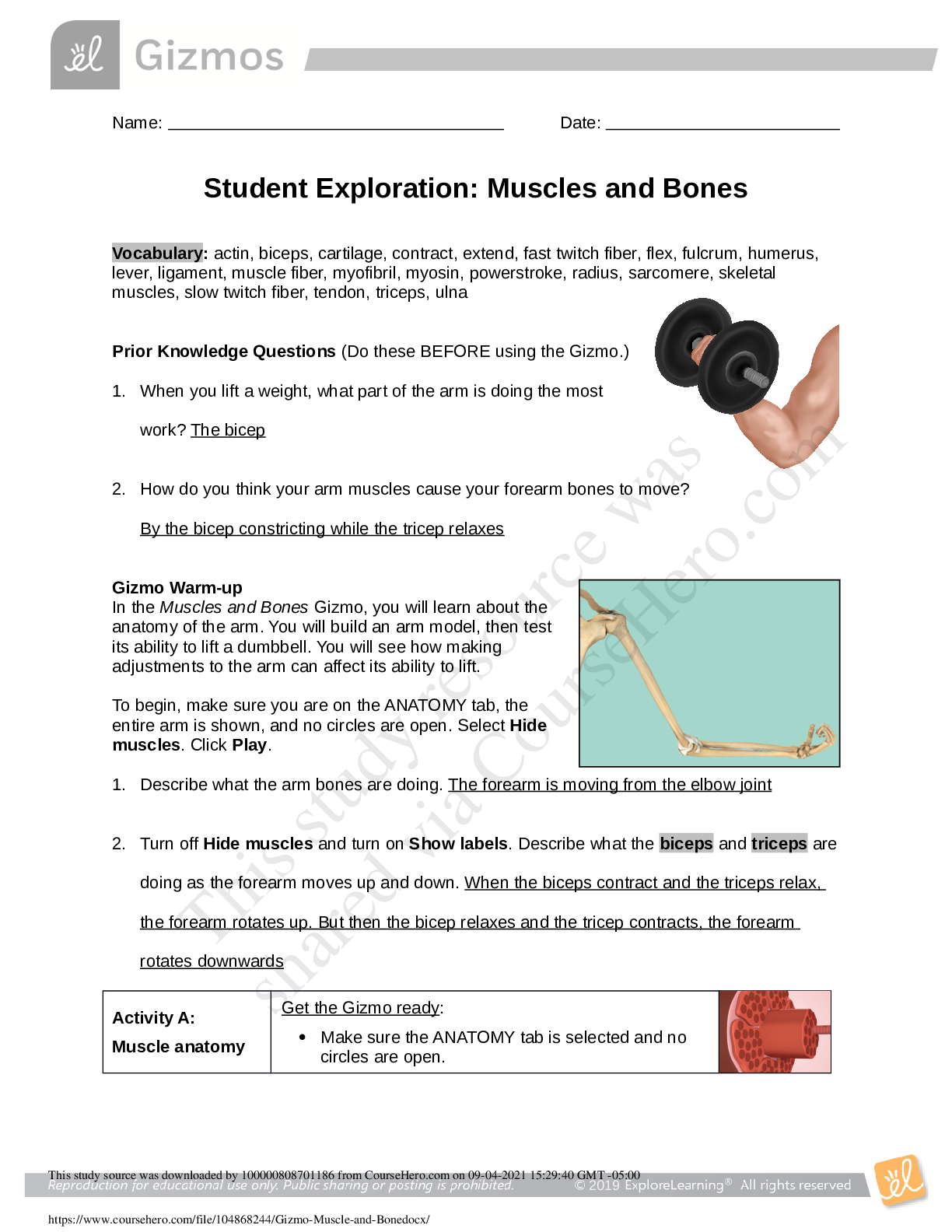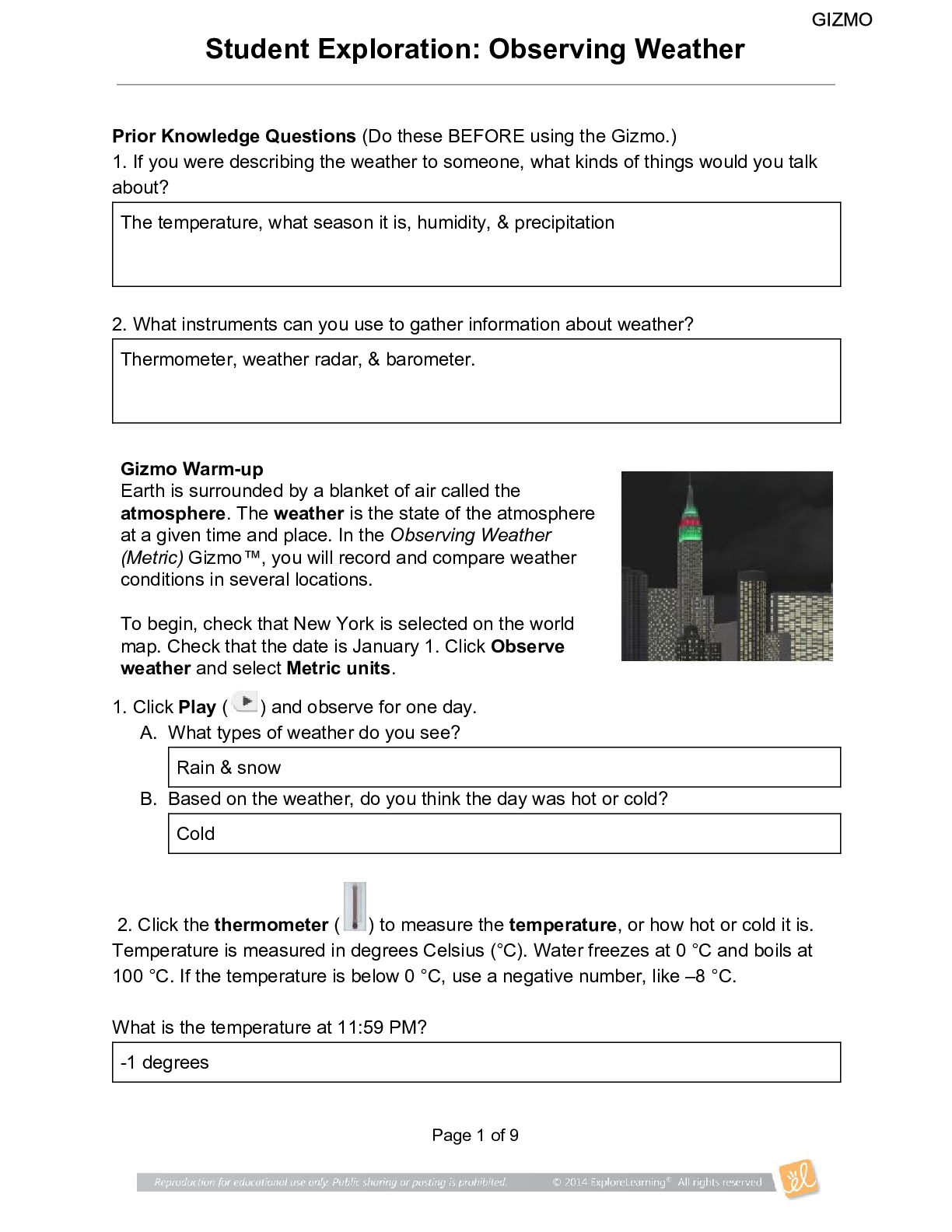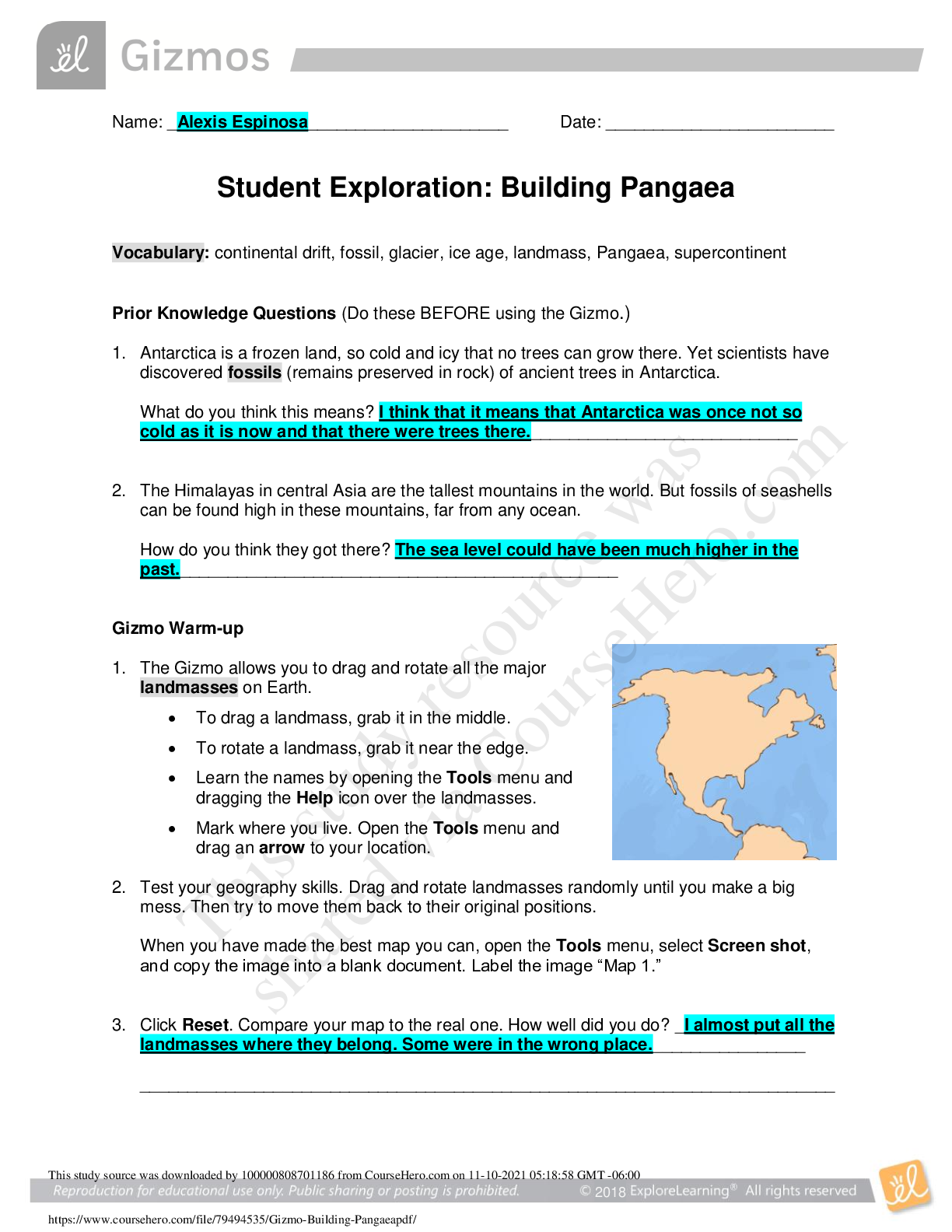ECON MaSt1010 .Introduction to Moles Gizmo
Document Content and Description Below
2019 Name: Date: Student Exploration: Moles Vocabulary: atomic mass, Avogadro constant, conversion factor, dimensional analysis, mole, molar mass, molecular mass, scientific notation, significant ... figures, unified atomic mass unit Prior Knowledge Questions (Do these BEFORE using the Gizmo.) 1. In the image to the right, note a dozen eggs, a dozen donuts and a dozen roses. How many of each item do you have? There is 12 of each item. 2. Would a dozen of each object have the same mass? No 3. Suppose you have a dozen carbon atoms, a dozen gold atoms, and a dozen iron atoms. Even though you have the same number of each, would you expect them all to have the same mass? Explain. I wouldn’t expect the same mass because each atom has its own amount of weight that it brings, different things have different mass. Gizmo Warm-up When counting roses, eggs, or donuts, a dozen is a good unit to use. If you are counting atoms, however, a dozen is not much help. In the Moles Gizmo, you will learn about a unit used to count atoms. On the AVOGADRO CONSTANT tab, place the copper (Cu) atom on the nano-balance on the left, which will show the average atomic mass of copper rather than the mass of a single copper atom. 1. What is the average mass of a copper atom? 63.546 u The unit “u” refers to unified atomic mass units. A single proton or neutron has a mass of approximately one atomic mass unit. (Officially, 1 u is one-twelfth the mass of a C-12 atom.) 2. To gain an idea as to how many atoms are in a gram or so of copper, use the larger balance on the right. Press Add atoms to put a scoop of atoms in the weighing dish, and keep adding until the balance registers between 1 and 2 grams. If you don’t seem to be making much progress, adjust the exponent using the slider, which will make the scoop size bigger. How many atoms did you need to add? 13 “needed to adjust my scoop size” This study source was downloaded by 100000825292796 from CourseHero.com on 05-04-2021 17:51:15 GMT -05:00 https://www.coursehero.com/file/60118799/Introduction-to-Moles-Gizmo-1docx/ This study resource was shared via CourseHero.com 2019 Activity A: Molar Mass Get the Gizmo ready: Select the AVOGADRO CONSTANT tab. Turn on Show hints and check that Copper (Cu) is selected. Introduction: Since atoms are so tiny, chemists have devised a unit known as the mole. A mole represents a macroscopic quantity of matter that can be used in the laboratory. One mole of any element has the same mass in grams as its atomic mass in u. Question: How many particles are in a mole? 1. Explore: Note the average atomic mass of copper on the nano-balance. Add atoms to the larger balance until it registers the same number (in g) as the reading on the nano-balance (in u). Use the Exponent slider to help get the correct amount. Stop adding atoms when the readings on both balances match exactly (to the nearest 0.001 g). How many atoms did you need to add? I added a good 35 just to get the equal amount. 2. Explore: Repeat the same procedure with carbon, then sulfur and aluminum. A. For each element, how many atoms did you need to add? I added 7 atoms using scoop size 20 & 23 for carbon. I added 10 atoms using scoop 19 and 22 for Sulfur. I added 29 scoops using scoop 23 & 20 B. What do you notice about the number of atoms in one mole? The number of atoms in one mole is equal. C. 3. Discover: In each case, you measured out one mole of atoms, since the mass of one mole of any element, in grams, is equal to its atomic mass, in u. One mole of any element contains the same number of atoms, a number known as the Avogadro constant. What is the exact value of the Avogadro constant? 4. Illustrate: The Avogadro constant is so large it is normally written in scientific notation. To get an idea of the enormity of the Avogadro constant, write it out in standard form. (You will need to move the decimal place to the right 23 times, so you will need to add a lot of zeros!) 5. Compare: While the number of atoms in a mole is constant, the number of grams in a mole changes based on the element. The number of grams in a mole (g/mol) is known as its molar mass, and has the same numerical value as an element’s atomic mass (in u). Use the Gizmo to find the atomic and molar mass of the following elements. Use proper units. This study source was downloaded by 100000825292796 from CourseHero.com on 05-04-2021 17:51:15 GMT -05:00 https://www.coursehero.com/file/60118799/Introduction-to-Moles-Gizmo-1docx/ This study resource was shared via CourseHero.com 2019 S: Atomic mass 32.065 Molar mass Al: Atomic mass 26.982 Molar mass (Activity A continued on next page) Activity A (continued from previous page) 6. Experiment: Select Copper(I) oxide, Cu2O. Note that Cu2O is a compound composed of different types of atoms bonded together. Place the Cu2O molecule on the nano-balance. A. What is the molecular mass of Cu2O? 143.09 B. Add molecules to the larger balance until its reading matches that of the nanobalance exactly. How many molecules did you need to add? C. Repeat the above procedure with another molecule of your choice. How many molecules did you need to add? 7. Summarize: Complete the following statements: A. 1 mole of any element contains 6.0221 × 1023 . B. 1 mole of any compound contains 6.0221 × 1023 . 8. Extend: For compounds, it is sometimes necessary to calculate the number of atoms of each element within a molecule. Select Iron(II) chloride. Note the image of the molecule. A. How many Fe atoms are within a single FeCl2 molecule? B. How many Cl atoms are within a single FeCl2 molecule? C. Use the nano-balance to find the mass of each of these atoms: Mass of Fe atom: Mass of Cl atom: D. Find the sum of their masses (1 Fe atom + 2 Cl atoms): E. Place the FeCl2 molecule on the balance. Is the sum of the masses of the individual atoms equal to the molecular mass of the compound? 9. Calculate: Select Copper(I) oxide. Note the image of the molecule. Place it on the balance. This study source was downloaded by 100000825292796 from CourseHero.com on 05-04-2021 17:51:15 GMT -05:00 https://www.coursehero.com/file/60118799/Introduction-to-Moles-Gizmo-1docx/ This study resource was shared via CourseHero.com 2019 A. How many moles of copper would be needed to make 1 mole of Cu2O? B. How many grams of copper would you need? Grams of oxygen? C. In addition to showing the ratio of atoms in a molecule, what else do the subscripts in a formula tell us? Activity B: Conversions Get the Gizmo ready: Select the CONVERSIONS tab. Select Carbon (C). Introduction: Chemical formulas represent ratios. To make H2O, you need two atoms of H for each atom of O; you would also need two moles of H for every mole of O. However, when performing experiments in the lab, substances are measured in grams, not atoms or moles. Therefore, it is important to be able to convert freely between atoms, moles, and grams. Question: How do you convert particles to grams, and grams to particles? 1. Investigate: Note the empty jars on the shelf that can be filled by using the slider. Set the amount to 2.000 moles of carbon (mol C), then press Start. Each jar holds exactly one mole of carbon. Your goal is to determine the mass in grams of two moles of carbon. A. Before you can find the mass, what do you need to know? B. Turn on Show molar mass. What is the molar mass of carbon? C. What do you think the mass of 2.000 moles of carbon will be? D. Drag the jars to the balance. What is the mass of 2.000 moles of C? 2. Estimate: Press Reset. Turn off Show hints. Using the first drop-down menu, select Grams. Set the amount to 46.00 g of carbon, then press Start. (Note that the substance appears in the weighing dish on the balance, not in the jars.) A. How many mole jars do you think can be filled with this amount? B. Place jars under the balance to find the mole amount. Were you close? This study source was downloaded by 100000825292796 from CourseHero.com on 05-04-2021 17:51:15 GMT -05:00 https://www.coursehero.com/file/60118799/Introduction-to-Moles-Gizmo-1docx/ This study resource was shared via CourseHero.com 2019 C. Press Reset and start with 151.00 g of FeCl2. How many mole jars do you think can be filled with this amount? D. Place jars under the balance to find the mole amount. What is the value? 3. Summarize: Consider the procedures you used to do the calculations in questions 1 and 2. A. How did you convert moles to grams? B. How did you convert grams to moles? (Activity B continued on next page) Activity B (continued from previous page) 4. Investigate: Press Reset. Start with 2.000 moles of sulfur, then press Start. A. How many atoms do you think this amount represents? B. Pour the jars into the atom counter at left. How many atoms are there? C. How can you calculate this value? 5. Estimate: Press Reset. Select Atoms, and using the slider, start with 1.000 × 1023 atoms of sulfur. (Note that pressing Start puts atoms into the atom counter, not the jars.) A. Is this amount more or less than one mole? B. Place the jar underneath the counter. Was the jar completely filled? C. How many moles do you have? 6. Calculate: Press Reset. Start with 1.900 × 1024 (or 19.00 × 1023) molecules of Cu2O. A. Calculate the number of moles: This study source was downloaded by 100000825292796 from CourseHero.com on 05-04-2021 17:51:15 GMT -05:00 https://www.coursehero.com/file/60118799/Introduction-to-Moles-Gizmo-1docx/ This study resource was shared via CourseHero.com 2019 B. Use the Gizmo to verify your calculation. Were you correct? C. Is the method for converting molecules to moles the same as that for atoms? 7. Summarize: Consider the procedures you used to do the calculations in questions 4 and 5. A. How did you convert moles to atoms (or molecules)? B. How did you convert atoms (or molecules) to moles? 8. Explain: Select Carbon and start with 2.0 × 1024 atoms. Press Start. A. Use the Gizmo to find the number of grams: B. Before you can find grams, what must you find first? C. How did you convert from atoms to grams? This study source was downloaded by 100000825292796 from CourseHero.com on 05-04-2021 17:51:15 GMT -05:00 https://www.coursehero.com/file/60118799/Introduction-to-Moles-Gizmo-1docx/ This study resource was shared via CourseHero.com 2019 Activity C: Dimensional Analysis Get the Gizmo ready: Select the DIMENSIONAL ANALYSIS tab. Start with Question 1. Introduction: Dimensional analysis is a method used to convert from one unit to another using conversion factors. A conversion factor is a fraction in which the numerator is equal to the denominator, such as 1molC 12.011 gC . Multiplying a quantity by a conversion factor(s) changes the unit, but not the value, since multiplying by a conversion factor is in essence multiplying by one. Question: How can dimensional analysis be used to make mole conversions? 1. Analyze: Note Problem 1 at the bottom of the Gizmo. A. What is the starting unit? What is the answer unit? B. What do you need to know in order to find the mass of 3.00 moles of carbon? 2. Calculate: Drag the appropriate conversion factor to the gray area. To make the units cancel, press Flip tile. It is important that all units cancel except the one you are trying to find. Check Show units to verify the ending unit, then check Show numerical results. A. What is the numerical result? B. Is this answer reasonable, given the mass of one mole of carbon? C. Press Check. Did you solve the problem correctly? In problem 1, note that the mole amount (3.00) is given to 3 significant figures. Significant figures are used to indicate the accuracy of a measurement, and express the confidence we have in that measurement. The zeros after the decimal point tell us with certainty that we do not have an additional tenth or hundredth of a mole. 3. Calculate: Using the Gizmo, solve problems 2, 3, and 4. Check each answer. Then, solve the problems below using the same techniques. Show your work. A. 95.0 g Al = mol Al B. 2.10 mol FeCl2 = molecules FeCl2 This study source was downloaded by 100000825292796 from CourseHero.com on 05-04-2021 17:51:15 GMT -05:00 https://www.coursehero.com/file/60118799/Introduction-to-Moles-Gizmo-1docx/ This study resource was shared via CourseHero.com 2019 (Activity C continued on next page) Activity C (continued from previous page) 4. Analyze: Select problem 5, which is more complex and cannot be solved in one step. In order to solve this problem, what two pieces of information do you need to know? Drag tiles into the gray area and solve. Check your answer when finished. Then do 6–12. 5. Calculate: In problem 13, note that you are being asked to find the number of atoms in a certain quantity of a compound. Before you can solve, it is necessary to determine the number of atoms within a single molecule. How many atoms are in a single molecule of FeCl2? Use the Gizmo to solve. Work through problems 14–19 for more of these types of problems. For additional practice, work through as many of the remaining problems as you wish. 6. Practice: Solve each of the following problems using dimensional analysis (or another method). Show your work. (Use a periodic table to look up the necessary atomic masses.) A. 75 g KMnO4 = molecules KMnO4 B. 7.23 × 1024 Al atoms = grams Al C. 9.23 × 1023 Au atoms = moles Au D. 125 g H3PO4 = molecules H3PO4 [Show More]
Last updated: 3 years ago
Preview 1 out of 9 pages
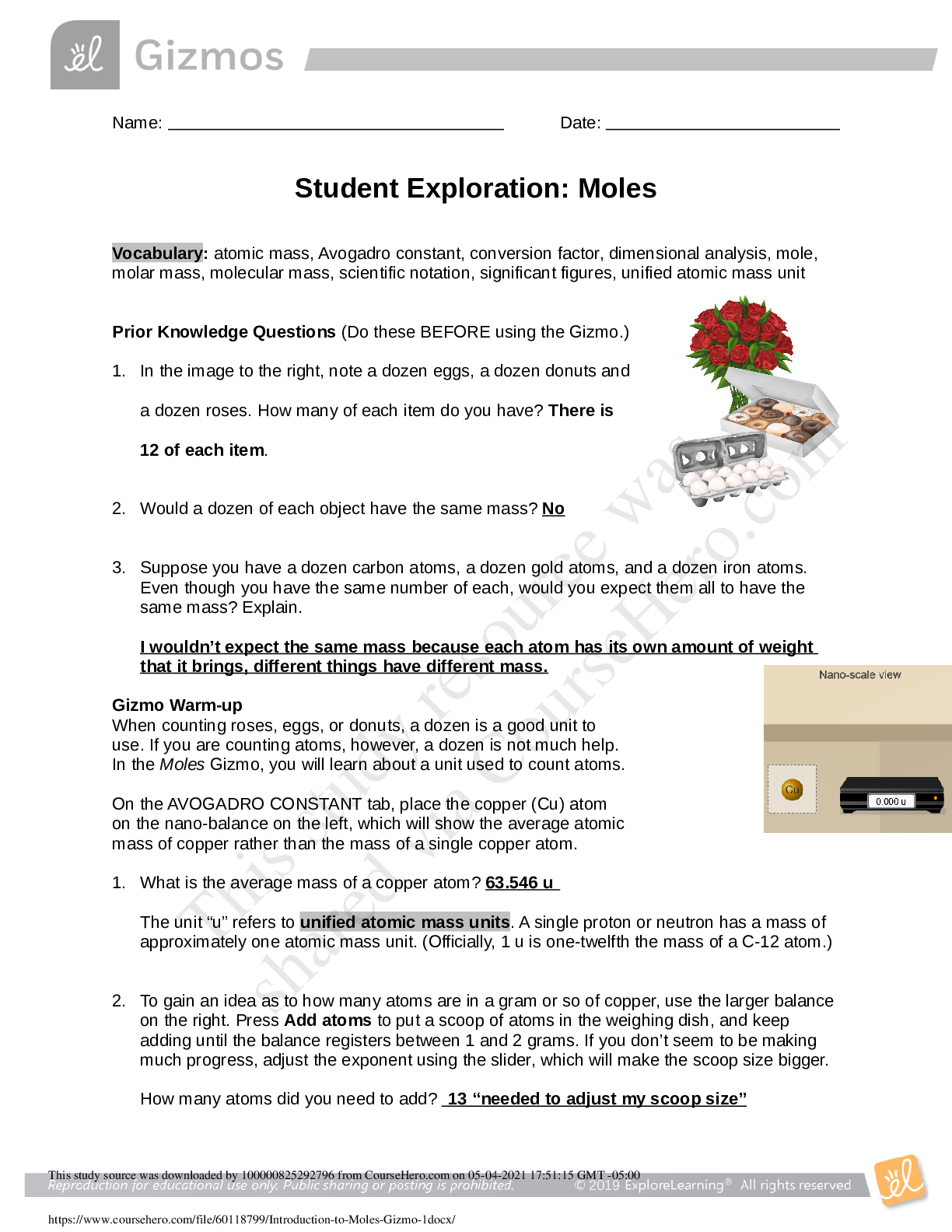
Buy this document to get the full access instantly
Instant Download Access after purchase
Buy NowInstant download
We Accept:

Reviews( 0 )
$7.50
Can't find what you want? Try our AI powered Search
Document information
Connected school, study & course
About the document
Uploaded On
May 05, 2021
Number of pages
9
Written in
All
Additional information
This document has been written for:
Uploaded
May 05, 2021
Downloads
0
Views
108


